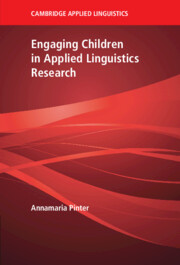Book contents
- Engaging Children in Applied Linguistics Research
- The Cambridge Applied Linguistics Series
- Engaging Children in Applied Linguistics Research
- Copyright page
- Contents
- Figures
- Tables
- Series Editors’ Preface
- 1 Setting the Scene
- 2 From Traditional to Contemporary Conceptions of Childhood
- 3 Voice, Agency and Participation
- 4 Child-Centredness and Democratic School Structures
- 5 Children’s Roles and Status in Applied Linguistics Research
- 6 Filling the Gap: What Kind of Research Is Needed?
- 7 Ethical Issues and Dilemmas
- 8 Towards Children’s Active Engagement in Applied Linguistics Research
- Appendix of Studies
- References
- Index
5 - Children’s Roles and Status in Applied Linguistics Research
Published online by Cambridge University Press: 05 October 2023
- Engaging Children in Applied Linguistics Research
- The Cambridge Applied Linguistics Series
- Engaging Children in Applied Linguistics Research
- Copyright page
- Contents
- Figures
- Tables
- Series Editors’ Preface
- 1 Setting the Scene
- 2 From Traditional to Contemporary Conceptions of Childhood
- 3 Voice, Agency and Participation
- 4 Child-Centredness and Democratic School Structures
- 5 Children’s Roles and Status in Applied Linguistics Research
- 6 Filling the Gap: What Kind of Research Is Needed?
- 7 Ethical Issues and Dilemmas
- 8 Towards Children’s Active Engagement in Applied Linguistics Research
- Appendix of Studies
- References
- Index
Summary
Chapter 5 discusses features of research involving children in applied linguistics. Based on a strategically selected ‘slice’ of the literature, namely, a survey of child L2 studies in five key applied linguistics journals between 2011 and 2021, a close analysis of children’s status and roles in research is undertaken. Observations are made about the type of studies (methodological solutions, tools, and approaches) dominating the field and about what is missing. Examples of studies in child second language education where children take up different types of passive roles are discussed and analysed. A handful of examples identified in the sample where the status and the roles of the children have been shifted away from entirely passive roles are also discussed. These examples are closely examined to identify the extent of active involvement that does not move beyond a ‘weak’ form of research ‘with’ children. The continuum of possibilities, research on-about-with-by children (Kellett, 2010a) is revisited here for further reflection.
Keywords
- Type
- Chapter
- Information
- Engaging Children in Applied Linguistics Research , pp. 103 - 126Publisher: Cambridge University PressPrint publication year: 2023

